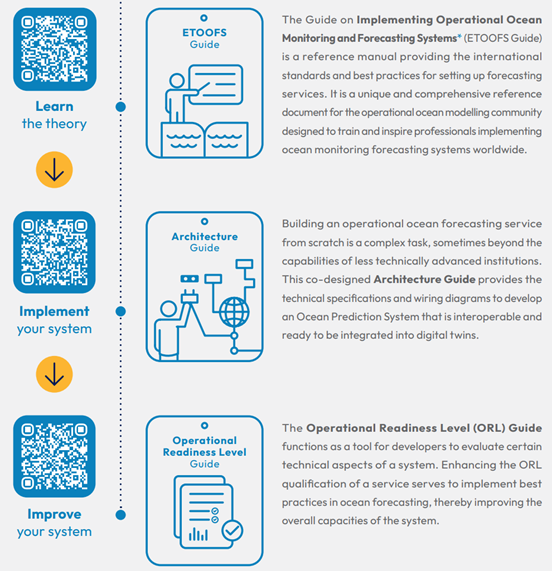An asset for capacity development and a roadmap to deliver as one.

Architecture
Coming soon!
Today, Operational Ocean Forecasting Systems (OOFS) have proven highly valuable. We have a range of successful and inspiring OOFS, contributing to cutting-edge know-how amongst the marine community. Nevertheless, we face the problem that the different existing services are technically quite disconnected. This is evident is several aspects:
- Core services are not sufficiently connected and interoperable amongst each other.
- There is no properly endorsed documentation, nor tools for building new systems, making it a very complex task. This is a relevant problem, especially to expand OOFS to developing Countries. This is, therefore, limiting the growth of our community and being a barrier to incorporating new ideas and relevant data and contributions that could enrich our common knowledge.
- Operating OOFS is complex and there are no clear best practices on how to do it.
- Once a system is developed it often ends up as an isolated service and there are very limited possibilities of using common tools for OOFS validation, dissemination, and exploitation.

All the above leads to redundant efforts and uncertainties regarding the quality of the existing services. OceanPrediction Decade Collaborative Center (OceanPrediction DCC) and its associated Decade actions are looking forward to changing this scenario considering that the Ocean Decade and the concept of digital twining opens an excellent opportunity for a significant breakthrough.
To advance towards this objective, OceanPrediction DCC has implemented the Ocean Forecasting Co-Design Team, formed by worldwide experts on different aspects of the value chain. This team has designed an Architecture for the future Ocean Forecasting services, with two main objectives:
- To overcome the above-mentioned limitations: this architecture will inspire the developments of the Decade Actions related to ocean forecasting. This will result in future collaborative and shared developments, promoting interoperability capabilities and allowing our community to deliver it as one.
- To serve, in combination with the ETOOFS (Expert Team on Operational Ocean Forecast Systems) Guide (Alvarez-Fanjul et al., 2022), as the basis for future capacity development activities.
- The Oceanprediction DCC architecture will work together with the ETOOFS guide and the Operational Readiness level as a tools for capacity building and development of ocean forecasting services.


Follow us